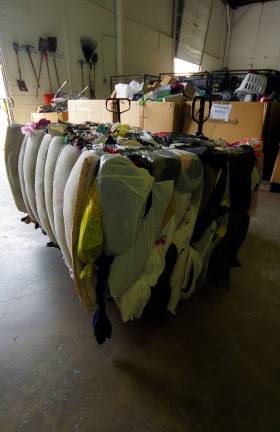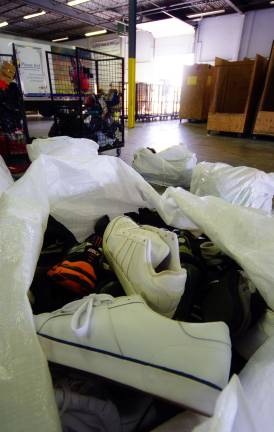Your ugly sweater’s a hot commodity






It’s Back to School, a time of year that has turned on its head into a holiday, full of ridiculous bargains to fend off the sorrow of summer’s end. But first, you’ve got to clear some space in your closet. Maybe you’ll lug your bag of single socks and too-short-and-too-wide sweaters to a Salvation Army, or else squash it into an overflowing clothing drop bin.
But hang on a minute. Can you think of anyone who would willingly accept the “gift” of your hand-me-downs? Where are our single socks and ill-fitting sweaters going? What happens to the collective ugly sweaters of America circa 2013, land of the largest walk-in closets full of the cheapest and most disposable clothes in history?
As it turns out, it makes no difference that no American would be caught dead in your unspeakably ugly sweaters. They are nonetheless a hot commodity and competition for them is fierce. That’s right, fierce. A booming industry has sprung up around the 2.5 billion pounds of clothes Americans donate annually. Charitable nonprofits vie for your castoffs with shady operations that are not above leave clothing donation bins in parking lots in the dark of night, without permission from the landowner. You’ve seen the lines of bins. Each represents a company scrambling to tap into this spewing volcano of free raw material that we think of as the dregs of our drawers.
Dirt started researching the used clothing industry by calling the number on a couple clothing donation bins. That wasn’t very effective. Textile recycling is an industry that by and large prefers to fly below the radar, which makes sense. Since people naturally feel virtuous about their donations, why complicate the issue with the information that their ugly sweater will not be handed out to a homeless person on a midnight run, but sold to a poor African? But isn’t that better than the sweater taking up space in a landfill and releasing methane as it decomposes? It all depends how you frame it. Suffice to say that if you dial the number on a donation bin and introduce yourself as a reporter, don’t sit by the phone waiting for a call back.
After toying with the idea of sewing a GPS chip into the pocket of a donated coat, and coming to the conclusion that the technology – if it existed at all – didn’t fit into our editorial budget, Dirt forgot about the story. That, of course, is when we stumbled across a couple outliers in the used clothes industry who were willing to talk.
Planet Aid, the company behind the ubiquitous canary yellow drop bins, reached out to Dirt about placing an ad, then extended an invitation to tour its warehouse. The 30,000 square-foot hub in Fairfield, N.J. is where Planet Aid trucks bring the contents of over 1,000 donation bins in the tri-state area.
It’s hot. Two workers wearing plastic gloves speak to each other in Spanish as they quickly sort through a pile of loose clothing that includes neckties and pajama pants, tank tops and Capri pants, a knee brace and what looks like a fleece boxing robe with a skeleton on the back, a baby shoe, a purse. These clothes exude an easy-come, easy-go air that suggests they were never much loved. They are the manifestation of the fact that we now pay less for our apparel – less than three percent of annual household budget – than ever in history. Even with the birth of this ravenous used clothing industry, we still only recycle 15 percent of our textiles; the other 85 percent ends up in the landfill.
Other than removing shoes and the stuff that’s obviously not clothes (like the wicker laundry basket that stands off to the side), Planet Aid doesn’t sort clothing. If donations come in a bag, the unopened bag goes straight into the bailer, to be hydraulically compressed and tied up with the loose clothing into 1,000-pound bales. The fewer times workers touch the clothes, the lower the overhead. The lower the overhead, the more money goes to Planet Aid’s international aid missions, like a five-day program that took place in July to train locals in Mozambique to establish gardens in rural primary schools.
“Eighty-four cents out of every dollar goes to the missions of the program. We run operations as lean as we can,” said Rick Henningsen, operations manager for the regional Planet Aid warehouse.
That said, Planet Aid understands that some people tend to think of the donation bins as dumpsters, and its workers will pick up anything in the vicinity of one of their bins and try to find a way to recycle it. They get mattresses, books, many a dropped cell phone, sinks and faucets, TVs. Once they received an inquiry from a woman who wanted to know whether they could find a use for her veteran husband’s prosthetic leg, which he never used. (They made some calls, but in the end could not.) Another time they got a panicked phone call from the family of a deceased person. Some well-meaning family member had dropped critical paperwork into a donation bin in a pocket of grandma’s clothes. (Planet Aid opened up the bin and found grandma’s will.)
After all, they’re eager to make a good impression on site hosts. Planet Aid is a nonprofit and doesn’t have the resources to “offer crazy amounts of money to a site host,” as some for-profit competitors do, said Henningsen. Some cities and towns don’t allow donation bins at all; others only allow a certain number. Planet Aid has a salesman whose job it is to secure permits to place donation bins. Those permits are particularly coveted when they’re in high traffic areas.
But “we’ll take any area that’ll take us,” said the salesman.
A packed bale sits in the warehouse, waiting to be loaded onto a truck. It could be studied as an anthropological artifact. Its bulging sides, compressed by wire, are blankets that were donated by a local company that tests the blankets’ flammability. Squashed between those blankets is a mishmash of discards from so many lives: a girl’s necklace of plastic flowers spilling over the wire binder, alongside price tags still attached to knitwear from Canal Jeans, a Brooklyn company that closed in 2002.
Eighty percent of the clothes that come through this warehouse will go to the port of Newark and then overseas, to African or South American countries or China, where an entire economy has grown up around our used clothes. Local entrepreneur types make their living buying bales sight unseen, sorting and pricing them, and selling the wares at a stall at open air markets.
Twenty percent will be snapped up by domestic buyers, perhaps sorting houses that go through the clothes and separate them by type and quality.
One such sorting house is Trans-Americas Trading Co., headquartered in Clifton, N.J. “We get the stuff that has no home,” said Ed Stubin, principal of Trans-Americas. “No one wants to wear a sweatshirt that’s got a stain on it. Dress for Success for example, they’re going to want to give women good usable clothing they can get a job interview in. Salvation Army, no one’s going to buy a sweatshirt with a hole or a stain on it. A lot of it is just not salable. There are no takers for it.”
Stubin has been in the textile recycling business for four decades. He used to run Trans-Americas. His son has since taken over. He sounds tired as he rejects the idea of a tour of his facility. The New York Times already wrote the story, he said. Indeed, in 2002 a reporter followed a stained t-shirt from the Upper East Side, through Trans-Americas, to the Ugandan man who ended up buying it.
But eventually Stubin warms up and starts talking.
Trans-Americas pays for thrift store excess by the trailer load – “bathing suits in January, sweaters in July” – sorts it into more than 300 categories, bales it and matches it with markets.
“If I get a t-shirt that has some holes in it, it’ll go into a wiping rag,” he said. More than half of the 70,000 pounds of used clothes that come through daily will be turned into rags or fiber to make things like insulation or automobile carpeting.
The better half sets sail from Newark to developing countries like India, Pakistan, or Uganda, where – again – locals will sell the clothing at stalls. A small but growing fraction will end up in American vintage boutiques. Ironically, those won’t be the clothes that are in the best condition.
“I can find a t-shirt with an imprint on it that’s been washed out and looks terrible. If I sold it to Africa, the people where it ends up wouldn’t even wear that,” said Stubin. “In most of the poor countries we ship to, it’s important that the quality of the clothing be good and strong, fashion’s not the critical issue. If I sold it here in the United States in a boutique, people might like that.”